

Fern-leaf inspires electrode for high density solar energy storage. Solar cells are constantly getting better at collecting energy from sunlight, but their ability to store it isn't improving quite as fast.
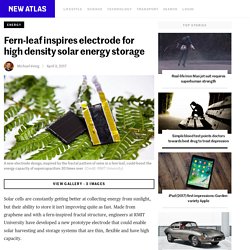
Made from graphene and with a fern-inspired fractal structure, engineers at RMIT University have developed a new prototype electrode that could enable solar harvesting and storage systems that are thin, flexible and have high capacity. While the sun is attractive as an energy source, solar-powered devices usually have to fall into two categories: those with big bulky setups, or smaller ones that don't need as much power. The RMIT team's new electrode is designed to bridge that gap, with a better energy density inspired at the microscopic level by the repeating pattern (called a fractal) seen in the veins of a species of American fern.
"The leaves of the western swordfern are densely crammed with veins, making them extremely efficient for storing energy and transporting water around the plant," says Min Gu, co-author of the study. New world record set for converting sunlight to electricity. An Australian team has set a new record for squeezing as much electricity as possible out of direct, unfocused sunlight via a new solar cell configuration.

Engineers at the University of New South Wales (UNSW) achieved 34.5 percent sunlight-to-electricity conversion efficiency, a new mark that also comes closer than ever to the theoretical limits of such a system. UNSW's Dr. Mark Keevers and Professor Martin Green set the record with a 28 centimeter-square (4.3 sq in), four-junction mini-module embedded in a prism. This new configuration allows the sun's rays to be split into four bands so that a higher amount of energy can be extracted from each beam. Latest bionic leaf now 10 times more efficient than natural photosynthesis. Over the last few years, great strides have been made in creating artificial leaves that mimic the ability of their natural counterparts to produce energy from water and sunlight.
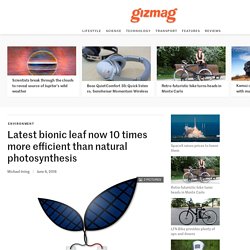
In 2011, the first cost-effective, stable artificial leaves were created, and in 2013, the devices were improved to self-heal and work with impure water. Now, scientists at Harvard have developed the "bionic leaf 2.0," which increases the efficiency of the system well beyond nature's own capabilities, and used it to produce liquid fuels for the first time. The project is the work of Harvard University's Daniel Nocera, who led the research teams on the previous versions of the artificial leaf, and Pamela Silver, Professor of Biochemistry and Systems Biology at Harvard Medical School.
Like the previous versions, the bionic leaf 2.0 is placed in water and, as it absorbs solar energy, it's able to split the water molecules into their component gases, hydrogen and oxygen. New world record set for converting sunlight to electricity. An Australian team has set a new record for squeezing as much electricity as possible out of direct, unfocused sunlight via a new solar cell configuration.

Engineers at the University of New South Wales (UNSW) achieved 34.5 percent sunlight-to-electricity conversion efficiency, a new mark that also comes closer than ever to the theoretical limits of such a system. UNSW's Dr. Mark Keevers and Professor Martin Green set the record with a 28 centimeter-square (4.3 sq in), four-junction mini-module embedded in a prism. This new configuration allows the sun's rays to be split into four bands so that a higher amount of energy can be extracted from each beam. All-weather solar cell design generates electricity come rain or shine. Numerous research efforts have already demonstrated the potential for graphene to improve the efficiency of solar cells.
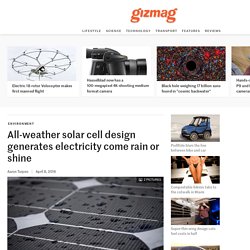
Now a team of researchers in China has leveraged the remarkable properties of the wonder material to develop a new all-weather solar cell design that is able to generate electricity when current solar cells can't – when it's raining. Amongst graphene's numerous impressive properties is its conductivity, which allows electrons to flow freely across its surface. When placed in an aqueous solution, this gives the material the ability to bind a pair of positively charged ions with a pair of its negatively charged electrons in what is known as a Lewis acid-base reaction. This property is exploited to remove lead ions and organic dyes from solutions and inspired a team led by Qunwei Tang to develop solar cells that generate electricity not only from the sun, but also raindrops. Laboratory tests using simulated rainwater proved out this theory.
Source: Wiley. Super-low loss quantum energy transport could revolutionize sunlight to energy conversion. The use of sunlight as an energy source is achieved in a number of ways, from conversion to electricity via photovoltaic (PV) panels, concentrated heat to drive steam turbines, and even hydrogen generation via artificial photosynthesis.

Unfortunately, much of the light energy in PV and photosynthesis systems is lost as heat due to the thermodynamic inefficiencies inherent in the process of converting the incoming energy from one form to another. Now scientists working at the University of Bayreuth claim to have created a super-efficient light-energy transport conduit that exhibits almost zero loss, and shows promise as the missing link in the sunlight to energy conversion process. Using specifically-generated nanofibers at its core, this is reported to be the very first time a directed energy transport system has been exhibited that effectively moves intact light energy over a distance of several micrometers, and at room temperature. Study claims perovskite solar cells can recoup their energy cost within three months. Scientists at Northwestern University and the U.S.
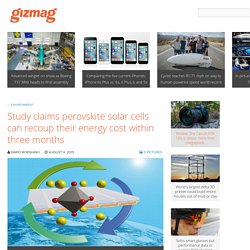
Department of Energy have found that perovskite cells, one of the most promising solar technologies of recent years, can repay their energy cost over 10 times faster than traditional silicon-based solar cells. The finding confirms that, once issues related to cell longevity are ironed out, perovskite cells could soon bring us solar energy on the cheap, and do so with less impact on the environment over their lifetime.
Solar panel installations are doubtlessly having a positive impact on the environment, but quantifying their carbon footprint with some degree of precision – which is useful for comparing them to other means of energy production, including other renewables – is not a straightforward process. According to this metric, called the cradle-to-grave life cycle assessment, a typical solar panel takes a fairly long time, between two and three years, to offset the energy costs that went into producing it. World's first "aqueous solar flow battery" outperforms traditional lithium-iodine batteries.
The scientists that revealed the "world's first solar battery" last year are now, following some modifications, reporting its first significant performance milestone.

The device essentially fits a battery and solar cell into the one package, and has now been tested against traditional lithium-iodine batteries, over which the researchers are claiming energy savings of 20 percent. It was last October that researchers at Ohio State University (OSU) first detailed their patent-pending design for a dye-sensitized solar cell also capable of storing its own power. With three electrodes rather than the typical four, it featured a lithium plate base, two layers of electrode separated by a thin sheet of porous carbon, and a titanium gauze mesh that played host to a dye-sensitive titanium dioxide photoelectrode.
As it no longer requires air to function, the battery can now be topped with a solid solar panel forming a single solid sheet. Solar panels made three times cheaper and four times more efficient. New energy cell can store up solar energy for release at night. A photoelectrochemical cell (PEC) is a special type of solar cell that gathers the Sun's energy and transforms it into either electricity or chemical energy used to split water and produce hydrogen for use in fuel cells.
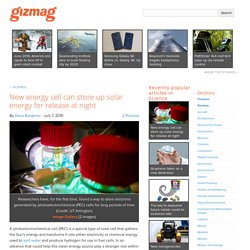
In an advance that could help this clean energy source play a stronger role within the smart grid, researchers at the University of Texas, Arlington have found a way to store the electricity generated by a PEC cell for extended periods of time and allow electricity to be delivered around the clock. Currently, the electricity generated by a PEC cell could not be stored effectively, as the electrons would quickly "disappear" into a lower-energy state. Spinach Powered Solar Cells. Category: New Inventions and Innovations (7)Sep-10-12 Researchers have developed a way to use spinach to create “biohybrid” solar cells, which could lead the way to a new generation of less expensive, more efficient solar panels.
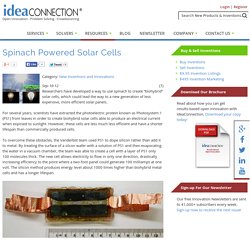
For several years, scientists have extracted the photoelectric protein known as Photosystem 1 (PS1) from leaves in order to create biohybrid solar cells able to produce an electrical current when exposed to sunlight. However, these cells are less much less efficient and have a shorter lifespan than commercially produced cells. To overcome these obstacles, the Vanderbilt team used PS1 to dope silicon rather than add it to metal. Better Black Solar Cells. Category: New Inventions and Innovations (7)Oct-12-12 Using strategic laser pulses, researchers have doubled the efficiency of black silicon solar cells, which are valued for their ability to harness infrared light. Black silicon is created by irradiating the silicon with laser beams in the presence of sulfur. The team, from Fraunhofer Institute, improved the efficiency of the black silicon by adjusting the laser beam pulses to change the position of the sulfur atoms in the silicon.
This change reduced the amount of infrared energy required to excite the elections into energy conversion by creating an intermediate level that allows the electrons to move more easily to the conduction band, where electricity is generated. At the same time, the new technology also helps prevent electrons from moving backwards off the band, reducing energy loss. First All-Carbon Solar Cell. Category: New Inventions and Innovations (6)Nov-04-12 Researchers have developed the first all-carbon solar cell, which could lead to a generation of flexible solar cells that could be coated on cars and windows.
While other groups have claimed to have created all-carbon cells, the carbon component has actually only been the middle layer. The new all-carbon cell, developed by a team at Stanford University, is actually made entirely of carbon—even the electrodes, which are made of graphene and single-walled carbon nanotubes. Under extreme conditions, carbon is able to outperform conventional devices, which would make it useful for areas of high temperatures or high physical stress. Solar Panel Backing Made of Cotton and Beans. Category: New Inventions and Innovations (5)Mar-21-13 The California company BioTech has eased the environmental impact of solar panel manufacturing by creating a protective cover made of castor beans and cotton.
The backing on solar panels that protects the silicon wafer is traditionally made from petroleum-based materials. As a greener option, the BioBacksheet is made from the resin of castor beans and the fibers of recycled cotton, which give the material firmness and structure. The material costs less to produce than current polymer backing sheets and is equally as strong. In addition, the BioBacksheet is made without petroleum or toxic chemicals. More Info: Add Comment Comments. Solar Cell Efficiency Improved Using Dots and Nanowires. Category: New Inventions and Innovations. Plant-Based Solar Cells. Category: New Inventions and Innovations (5)Mar-31-13 Using plant-based materials, researchers have developed efficient, organic solar cells that can be dissolved in water and recycled. Until now, organic solar cells had usually been fabricated on glass or plastic. The new solar cells, created by researchers at the Georgia Institute of Technology and Purdue University, are fabricated on cellulose nanocrystal (CNC), which is derived from plants.
The CNC substrate is transparent, so light can pass through, and can be separated into its main components by soaking it in warm water. Hybrid Solar System Helps Green Natural Gas Plants. Hybrid Solar System Helps Green Natural Gas Plants. IBM Solar Collector Harvests the Power of 2000 Suns. Creating Solar Cells in Microwave Ovens. Improving Silicon with Hydrogen. Improving Silicon with Hydrogen (3)May-09-13 By controlling the charge state of hydrogen atoms, researchers have developed a way to produce high efficiency solar cells from inexpensive, low-grade silicon. While researchers have known for years that hydrogen atoms can be used to help correct the defects of low-grade silicon, controlling the hydrogen atoms to achieve maximum efficiency has been difficult.
Window Socket Solar-Powered Outlet. Flat Solar Panels Could Replace Roof Tiles. Everlasting Solar Battery. Solar-Wind Hybrid Power. Harnessing Solar Power from Space. New Solar Cell Connection Tolerates Energy of 70,000 Suns. World's First Solar Sidewalk. Thinner, Cheaper Dye-Based Solar Cells. Ultrathin Solar Film Traps Photons. Making Solar Cells From Copper Nanowires. Tin-Based Solar Cells Replace Hazardous Lead. New Nanoparticle Could Lead to Inkjet-Printed Solar Cells. First Integrated System to Generate Both Electricity and Heat.
Tofu Ingredient Could Make Solar Cells Greener. Plastic-Based Graphene Could Offer an Affordable Substitute. MIT Sponge Converts Solar Energy to Steam. Self-Cooling Solar Cells. Adaptive Material Could Halve Solar Panel Costs. Perovskite Boosts Spray-On Solar Efficiency. Transparent Solar Panels Capture Invisible Light. Affordable SprayLD Could Lead to Solar Roofs. New world record claimed for organic solar cell efficiency. Eyes inspire more efficient solar cell architecture.